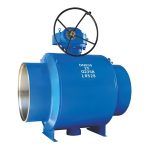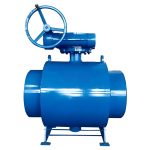TIANYU Class 150 DN300-DN1000 WCB Carbon Steel Full Welded Trunnion-Mounted Ball Valve: Worm Gear Operated Soft-Sealed Flow Control Solution for Large-Diameter Industrial Pipelines
I. Product Overview
II. Key Attribute Specifications
A. Dimensional & Pressure Parameters
- Nominal Diameter (Port Size): DN300 to DN1000 (12-inch to 40-inch), covering the core range of large-diameter industrial pipelines. The full-port design minimizes flow resistance, ensuring a flow coefficient (Cv) of up to 5000 for DN1000 models, which meets the high-flow demands of municipal water mains and industrial process lines.
- Pressure Rating: Class 150 (PN16, 1.6MPa working pressure) as standard, with optional upgrades to Class 300 (PN40) and Class 600 (PN100) for high-pressure applications. Hydrostatic test pressure adheres to API 598 standards: 1.5×rated pressure (2.4MPa for Class 150) for the valve shell and 1.1×rated pressure (1.76MPa for Class 150) for the seat, ensuring structural integrity and sealing reliability.
- Temperature Range: -29℃ to 300℃, enabled by WCB carbon steel’s thermal stability and soft sealing materials. This range covers most ambient, medium-temperature, and moderately high-temperature industrial media, from chilled water to hot oil and saturated steam.
B. Material Composition
- Valve Body & Bonnet: WCB cast carbon steel (ASTM A216), featuring a tensile strength of 485-655MPa and yield strength ≥240MPa. Post-casting normalization heat treatment (890-950℃ air cooling) relieves internal stresses, preventing deformation under thermal cycling. For corrosive environments, optional materials include 304/316 stainless steel (CF8/CF8M) and alloy steel (WC6/WC9).
- Ball & Trunnions: 1045 carbon steel (standard) with chrome plating (hardness ≥60 HRC) for wear resistance; optional 304/316 stainless steel for enhanced corrosion resistance. The trunnions are integrated with the ball and supported by bronze bearings, ensuring smooth rotation under high pressure.
- Sealing System: Soft sealing based on PTFE (polytetrafluoroethylene) or reinforced PTFE (RPTFE), offering chemical inertness and bubble-tight sealing. PTFE operates within -29℃ to 200℃, while RPTFE extends the upper temperature limit to 260℃ and improves mechanical strength.
- Worm Gear & Stem: Worm gear box housing made of cast iron (HT200) with precision-machined steel worm and bronze worm wheel, ensuring high transmission efficiency. The stem is crafted from 2Cr13 stainless steel, polished to reduce friction and prevent media leakage along the stem.
C. Connection & Operational Features
- Connection Type: Full welded (butt weld), complying with ASME B16.25 standards. The welded joint forms a monolithic structure with the pipeline, eliminating gasket-related leakage risks and enhancing structural stability—ideal for buried or high-vibration pipeline systems.
- Operation Mode: Worm gear manual operation. The gear reduction design reduces operating torque by 60-70%, allowing a single operator to fully open/close DN1000 Class 150 valves with a torque of ≤1500 N·m. The handwheel is equipped with a position indicator for clear operational status.
- Leakage Class: ANSI/FCI Class VI (soft seal), achieving “zero leakage” performance (≤0.1×DN mm³/min leakage) for clean media such as water, oil, and natural gas. This meets the strict sealing requirements of energy-saving and environmental protection standards.
- Safety Features: Built-in electrostatic discharge device connects the ball, stem, and body to prevent static buildup and potential sparks. Optional fire-safe design (API 607) provides secondary metal-to-metal sealing in case of soft seal damage due to fire.
D. Certifications & Compliance
- Core certifications include API 6D (pipeline valve standard), ISO 9001 (quality management system), and CE (EU safety compliance).
- Optional certifications cover NACE MR0175 (for sour service with H₂S-containing media) and ISO 15848 (low-emission standards for toxic or flammable media).
- Dimensional compliance with ASME B16.10 (face-to-face dimensions) and MSS SP-25 (product marking).
III. Feature Description
A. Full Welded Structure: Leak-Tight Integrity for Critical Pipelines
B. Trunnion-Mounted Ball Design: Stability Under High Flow & Pressure
C. Worm Gear Drive: Efficient Operation for Large-Diameter Valves
D. Soft Sealing System: Zero Leakage & Chemical Compatibility
E. Safety Enhancements: Electrostatic Discharge & Optional Fire-Safe Design
IV. Manufacturing Processes
A. Material Inspection & Preparation
- WCB Carbon Steel Verification: Raw WCB billets undergo spectral analysis to confirm chemical composition (C: 0.25-0.35%, Mn: 0.60-1.00%) and ultrasonic testing (UT) to detect internal porosity or cracks. Mechanical testing (tensile, impact) ensures compliance with ASTM A216 standards, particularly impact toughness at -29℃.
- Seal Material Testing: PTFE/RPTFE seals are tested for dimensional stability, compression set, and chemical resistance at extreme temperatures (-29℃ to 300℃) to ensure they retain sealing properties under operational conditions.
- Worm Gear Component Inspection: Steel worm and bronze worm wheel blanks are inspected for material purity and machinability, with hardness testing (worm: ≥28 HRC, worm wheel: ≥150 HB) to ensure wear resistance.
B. Valve Body Welding & Heat Treatment
- Full Welded Body Fabrication: The valve body is manufactured using precision butt welding technology. The body halves are cut from WCB steel plates using plasma cutting, then machined to ensure precise fit-up. Welding is performed via submerged arc welding (SAW) for high-quality, consistent welds, with continuous monitoring of welding parameters (current, voltage, speed) to prevent defects.
- Post-Weld Heat Treatment (PWHT): Welded bodies undergo stress relief annealing at 600-650℃, held for 2-3 hours, then slow-cooled to room temperature. This process reduces residual welding stresses by 60-80%, preventing cracking under thermal cycling or pressure.
- Non-Destructive Testing (NDT): Welded joints are inspected using radiography (RT) to detect internal defects and liquid penetrant testing (PT) to check for surface cracks. All welds must meet API 6D NDT requirements (Level II).
C. Precision Machining of Critical Components
- Ball & Trunnions: The ball is CNC-turned to a spherical tolerance of ±0.02mm, then lapped to a surface roughness of Ra ≤0.8μm using diamond abrasives. Trunnions are integrated with the ball and ground to a diameter tolerance of h7 (±0.015mm) for smooth rotation in bronze bearings.
- Valve Seat & Seal Pockets: Seat pockets are CNC-machined to match the ball’s curvature, with a surface roughness of Ra ≤1.6μm. The soft seals are precision-cut and pressed into the pockets, with spring-loading to ensure uniform sealing pressure.
- Worm Gear Box Machining: The cast iron housing is CNC-machined to ensure precise alignment of the worm and worm wheel. Gear teeth are hobbing-machined to AGMA Class 8 precision, with a surface finish of Ra ≤1.6μm to reduce friction and backlash.
- Stem Machining: The 2Cr13 stainless steel stem is turned, ground, and polished to a surface roughness of Ra ≤0.4μm, with a precision thread for connection to the worm gear and ball. A packing groove is machined to accommodate graphite-impregnated PTFE packing for stem sealing.
D. Assembly & Quality Testing
- Component Assembly: The ball-trunnion assembly is inserted into the valve body, with bronze bearings installed to support the trunnions. The stem is connected to the ball and worm gear, with packing installed to prevent stem leakage. The worm gear box is mounted to the valve bonnet, aligned via laser to ensure 90° ball rotation with no binding.
- Hydrostatic Testing: The valve is filled with water for shell and seat testing. The shell is pressurized to 2.4MPa (1.5×Class 150) for 30 minutes, with no leakage or deformation allowed. The seat is tested at 1.76MPa (1.1×Class 150) for 15 minutes, with leakage measured using a bubble counter to confirm ANSI/FCI Class VI compliance.
- Operational Testing: The worm gear operation is tested to confirm torque ≤1500 N·m for DN1000 models. 100 open-close cycles are performed to verify smooth operation and consistent sealing. The position indicator is calibrated to ensure accurate alignment with the ball’s position (open/closed).
- Final Inspection: Dimensional checks confirm compliance with ASME B16.10 and ASME B16.25 standards. Material traceability documents, test reports, and certification paperwork (API 6D, ISO 9001) are compiled for delivery.

V. Product Advantages
A. Superior Leak-Tightness & Structural Stability
B. Cost-Effective & Low Maintenance
C. Wide Temperature & Media Compatibility
D. Compliance with Global Standards
E. Safety & Environmental Compliance
VI. Product Applications
A. Municipal Water Supply & Drainage
- Large-Diameter Water Mains: TIANYU’s DN300-DN1000 valves control flow in municipal water distribution networks. The full welded structure withstands soil corrosion and vibration, while the soft seal ensures zero leakage to conserve water. The worm gear drive simplifies operation for maintenance crews, even in remote locations.
- Sewage Treatment Plants: The valve regulates flow in sewage collection and treatment lines. PTFE seals resist corrosion from organic matter and chemicals in sewage, maintaining sealing performance for 5+ years. The trunnion design handles high flow rates in main sewage pipelines, preventing blockages and ensuring efficient treatment.
B. Petroleum & Natural Gas Industry
- Crude Oil Refineries: Used in crude oil distillation units and product pipelines, the valve controls flow of hot oil (up to 300℃) and refined products (e.g., gasoline, diesel). The optional fire-safe design and electrostatic discharge device enhance safety in flammable environments. API 6D compliance meets pipeline operator standards (e.g., ExxonMobil, Shell).
- Long-Distance Gas Pipelines: Acts as isolation valves in natural gas transmission lines. The full welded structure is suitable for buried installation, with anti-corrosive coating resisting soil moisture and chemicals. Bidirectional sealing handles reverse flow during pipeline pigging, ensuring system integrity.
C. Chemical Processing
- Basic Chemical Plants: Regulates flow of mild chemicals (e.g., ethylene, propylene) and solvents in polymerization processes. PTFE/RPTFE seals resist chemical attack, while WCB carbon steel handles high pressure (up to Class 600 optional). The valve’s zero leakage performance prevents product contamination and environmental pollution.
- Pharmaceutical & Food Processing: For water, steam, and inert gas lines, the soft seal ensures clean, contamination-free flow. The valve’s smooth internal surfaces (Ra ≤0.8μm) prevent media buildup, meeting hygiene standards (e.g., FDA requirements for food contact surfaces).
D. Power Generation
- Coal-Fired Power Plants: Controls flow of cooling water and steam in boiler auxiliary lines. WCB carbon steel’s high-temperature stability (up to 300℃) resists thermal stress, while the trunnion design handles high flow rates in cooling water systems. The worm gear drive’s low torque enables easy operation during maintenance shutdowns.
- Nuclear Power Plants (Non-Radiation Zones): Used in secondary cooling systems, the valve’s structural stability and leak-tightness meet nuclear safety standards. Optional stainless steel construction resists corrosion from demineralized water, ensuring long-term reliability.
E. Steel & Metallurgy
- Steel Mills: Regulates flow of water and steam in blast furnace cooling systems and rolling mill processes. The valve’s high flow capacity (up to 10,000 m³/h for DN1000) handles large cooling water demands, while the welded structure withstands vibration from mill equipment. PTFE seals resist scaling from mineral-rich cooling water, reducing maintenance frequency.
F. Port & Marine Facilities
- Oil Terminals: Controls flow of crude oil and petroleum products in loading/unloading lines. The full welded structure resists saltwater corrosion (with optional anti-corrosive coating), while the electrostatic discharge device prevents static-related accidents. API 6D compliance meets marine industry standards for offshore and onshore terminals.
RELATED
-

High Temperature/Pressure 304 Stainless Steel Resistant Manual Power Forged Three Piece Flanged Floating Ball Valve
TIANYU 304 Stainless Steel Flanged Floating Ball Valve: Corrosion-Resistant Full-Port Flow Control Solution for Industrial, Sanitary, and Municipal Me…
BALL VALVE 11/03/2025 -

API ANSI 2in-16in DN50-DN400 PN10 PN16 CF8M Pneumatic Flanged Floating Ball Valve
TIANYU CF8M Pneumatic Flanged Floating Ball Valve: 2in-16in (DN50-DN400) PN10-PN16 API/ANSI Class Corrosion-Resistant Flow Control Solution for Indust…
BALL VALVE 11/01/2025 -

Large-Diameter DN1400 CLASS150 WCB SS Triple Eccentric Metal-Sealed Hard Seal Butterfly Valve
TIANYU DN1400 (56″) CLASS 150 WCB Hard Seal Butterfly Valve: Triple Eccentric Metal-Sealed Flanged Valve for Large-Diameter Industrial Media wit…
BUTTERFLY VALVE 10/30/2025 -

PN16 Stainless Steel Floating Ball Valve: Full Port 2PC Flange-Connected Valve with Fire-Safe & Anti-Static SS Ball Valve
TIANYU Stainless Steel Floating Ball Valve: Full Port 2PC Flange-Connected Valve with Fire-Safe & Anti-Static Design for Oil, Gas, and Industrial …
BALL VALVE 10/29/2025 -

High-Performance DN80 Class 150 WCB Soft-Sealed Lug-Type Double Eccentric Butterfly Valve
TIANYU 3” Class 150 WCB lug-type double eccentric butterfly valve is a technologically advanced flow control device engineered to address the challeng…
BUTTERFLY VALVE 10/25/2025 -

DN125 PN16 CF8M Stainless Steel Lug-Type Butterfly Valve with PTFE Lining Concentric Line Butterfly Valves
TIANYU DN125 PN16 CF8M stainless steel lug-type butterfly valve is a precision-engineered flow control device designed to address the challenges of ha…
BUTTERFLY VALVE 10/25/2025






